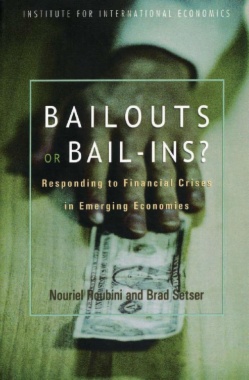Roughly once a year, the managing director of the International Monetary Fund, the US treasury secretary and in some cases the finance ministers of other G-7 countries will get a call from the finance minister of a large emerging market economy. The emerging market finance minister will indicate that the country is rapidly running out of foreign reserves, that it has lost access to international capital markets and, perhaps, that is has lost the confidence of its own citizens. Without a rescue loan, it will be forced to devalue its currency and default either on its government debt or on loans to the country's banks that the government has guaranteed.
This book looks at these situations and the options available to alleviate the problem. It argues for a policy that recognizes that every crisis is different and that different cases need to be handled within a framework that provides consistency and predictability to borrowing countries as well as those who invest in their debt.
- Cover
- Contents
- Preface
- Acknowledgments
- Chapter 1 Introduction
- Why Crisis Resolution?
- Purging Unhelpful Myths
- Closing the Gap Between Rhetoric and Reality
- Agenda for Reform
- Structure of the Book
- Chapter 2 New Nature of Emerging-Market Crises
- Sources of Vulnerability in Emerging-Market Crises
- Interpreting Recent Crises
- Conclusions
- Chapter 3 Analytical Literature on Crisis Resolution
- Four Approaches to Crisis Resolution
- Crisis Resolution in IMF’s Absence
- IMF, Crises of Creditor Coordination, and Moral Hazard
- Do Partial Bailouts Ever Work?
- Policy Implications and Suggestions for Further Research
- Chapter 4 Experience with Bailouts and Bail-ins
- Experience with Official Financing
- Experience with Bail-in Policies: Rollover Arrangements and Debt Exchanges
- Lessons for the Official Sector
- Lessons from Bond Restructurings
- Lessons from Restructuring of Bank Claims
- Conclusions
- Chapter 5 Official Policy Toward Crisis Resolution
- Reaction to Mexico’s Bailout
- Reform of the International Financial Architecture
- The Debate Fractures
- A New Administration, a New Policy?
- Conclusions
- Chapter 6 Responding to Liquidity Shortages
- When Is Official Liquidity Support Warranted?
- Are Targeted Debt Reschedulings Inequitable?
- Risks of Gradual Escalation
- Case for Pragmatism
- Private-Sector Financial Difficulties
- Alternative Approaches to Liquidity Crises
- What Is the Right Policy?
- Chapter 7 Seniority of Sovereign Debts
- Relative Treatment of Different Sovereign Claims
- Domestic Versus External Debt
- Arguments in Favor of a Formal Debt Seniority Regime
- Conclusion
- Chapter 8 Legal Reform
- Potential Obstacles to Sovereign Debt Restructuring
- Approaches to Legal Reform
- Codes and Committees
- Assessing Reform Proposals
- Conclusion
- Chapter 9 Recommendations for Reform
- “Hardware” Largely in Place
- Problems with Crisis Resolution “Software”
- Moving from Problems to Solutions
- Conclusion
- Appendix A Tables
- References
- Glossary
- Index

